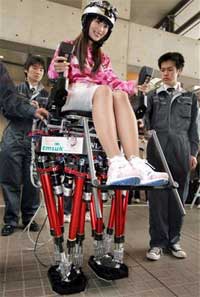 |
| Robot WL-16RIII (Source: Reuters) |
A team of Japanese scientists is developing a bipedal robot that promises to replace human legs for mobility among the elderly and people with disabilities.
The current version of this robot stands at 1.28 meters tall. Its actual form resembles a mobile chair supported by two mechanical legs. The individual seated in the chair can control its movement using two joysticks. This represents a remarkable fusion of precision mechanics and information technology. It is the information technology that will make operating the robot easier and more convenient.
Furthermore, digital technology will be the key to developing biological control methods that will gradually be integrated into future generations of this robot. The operator may eventually control the robot’s movements using their thoughts, achieving a level of flexibility comparable to that of natural legs.
The development team stated that it will take at least five more years for this robot to be fully suitable for elderly users. Currently, the device has a slow response time and movement speed, and it needs to be reinforced to support greater loads.
The primary goal of developing this robot is to assist the elderly and those with health limitations, enabling them to integrate better into the community.
TRAN HUY



















































